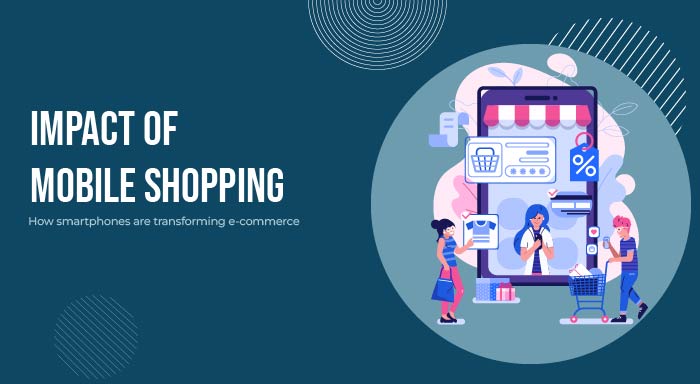From communications and entertainment to shopping, over the last decade, smartphones have reinvented almost every aspect of our life. E-commerce has brought about a sea of changes in the modern shopping landscape: yet despite all the innovations it has led, the development of mobile shopping, or e-commerce.
It has also revolutionized the availability of the e-commerce marketplace to offer greater access, personalization, and convenience. They shape the manner in which customers surf, buy, and relate to brands in cyber space with the continually increasing smartphone influence on everyday life.
New Era in Mobile Shopping
In that context, some recent trends causing a rise in mobile shopping are the prevalence of smartphones, faster internet connection, and the convenience of browsing on-the-move. A shopper is no longer restricted to his or her desktop to search through an online store. The results show that according to the majority of the recent studies, more than 79 percent of mobile users reported to have bought a product through their mobile device, and the ratio is increasing day by day.Of course, the e-commerce market everywhere is hot and more retailers are becoming conscious of the changed scenario. The brands are investing heavily in mobile-friendly websites, applications, and marketing strategies to help reach the growing number of mobile shoppers. Whether it is a social media browse, checking mail, or a dedicated application, the smartphones have just made shopping almost seamlessly a part of everyday life.
Easy Accessibility and Convenience
The greatest importance of mobile shopping is its convenience. It allows consumers to shop whenever and wherever they want with the aid of their smartphones.
What could be a simple purchase? A late night browse, or an after-work "stop by" at the store can now be done without having to sit in front of a computer or physically visit a store.
Accessibility has opened up not only new markets but also demographics. Consumers in rural areas or those restricted by less access to physical stores can now shop from global merchants through e-commerce. For that matter, persons with hectic schedules can manage to fit shopping into their already crowded days without needing to take time out for it. Such flexibility is among the major reasons behind mobile shopping's success.
Personalization and Mobile Commerce
The level of personalization, another transformation phase through smartphones in e-commerce has been brought. Desktop shopping is far less personalized compared to mobile devices as it relates to the user's behavior. Now, thanks to very sophisticated algorithms and data collection, e-commerce platforms can analyze a user's browsing patterns, his/her search history, and social media activity to make highly personal product recommendations.
It includes push notifications, personalized ads, and in-app promotions that appeal to individual preferences, hence making the shopping experience feel more personal and engaging. Consumers are more responsive to the offers that personalize contents for them, and therefore most branded conversions are recorded because of such customized offers. Retailers can use geolocation data to provide deals or in-store offers to those customers who are closer than a certain proximity range further enhancing the mobile shopping experience.
Role of Mobile Applications in E-commerce.
For many e-commerce platforms, mobile applications are game-changers. Although it is necessary to have a website that is mobile-friendly, an app brings much more efficiency and effectiveness to their operations. Most applications have features that cannot be accessed on a website, including faster loading times, better user interface designs, and built-in payment options like Apple Pay or Google Wallet, all of which tend to make the checkout process easier.
Apps can also send push notifications directly from brands to their consumers. This way it becomes easier to notify about sales promotions or order updates. It is even possible to make the relationship more engaging by reminding users of a sale or promotion or an update on an order, while many retailers have actually created loyalty programs within their apps to continuously offer rewards to customers in the form of discounts and benefits as a result of repeat purchases.
For example, global brands such as Amazon, eBay, and Alibaba dedicated a large share of their sales to their individual mobile apps. So have smaller businesses realized the importance of these mobile applications. They begin one after the other to tap into a growing mobile-first audience.
Mobile Payment Solutions and Security
Something that has always been a significant concern with online shopping is the safety of paying. Mobile shopping, however, has seen rapid advance in ensuring this safety and simplicity in terms of transactions. The payment gateway has been enhanced to accept mobile wallets such as Apple Pay, Google Pay, or PayPal, which have made mobile payments smoother and more secure.
Such mobile payment solutions are quite easy and friendly to use, allowing consumers to make purchases with a few taps. No more credit card details to be entered with every single transaction, but through mobile shoppers, one can store all the details securely and experience the checkout process in a faster and improved manner.
Each side has also experienced their side strengthen on security issues. For example, they come up with more robust logins, including two-factor authentication, integrate biometric security such as the recognition through fingerprints or faces, and use encryption protocols that ensure safe storage of consumers' information. Consumers are, therefore, increasingly feeling safe when using their smartphones to shop, hence moving e-commerce into new heights.
Using social media and mobile commerce
The feature of social media has always influenced consumer behavior; it merely narrows the relationship between social platforms and e-commerce to the extent of mobile shopping. Instagram, Facebook, TikTok, and Pinterest are no longer used solely as domains for social interaction these days; rather, they have also become virtual storefronts.
It is a social-commerce platform, where customers can shop directly from social media sites. For instance, one can now shop directly from news feed posts, stories, and ads on Instagram. As the number of Gen Z users on TikTok grows, it is fast becoming one of the best places to find new products and make impulse purchases.
The influence of combining social interaction with e-commerce is incredibly strong. Influencers have a massive impact on mobile shopping, using platforms for product presentations and recommendations to their followers. The resultant trend driven more by influencers has culminated in the increasing rise of impulse buying. Consumers buy instinctively without caution and wittingly or unwittingly because of the recommendation they find on social media feeds.
AR, AI, and Voice Search: The Future of Mobile Shopping
The future of mobile shopping looks extremely promising, and various emerging technologies are looking to make it better. A leading aspect here is AR, which has already changed the face of mobile e-commerce. With it, the consumer can visualize a product in their home or even on themselves before buying that item. Whether it is a virtual try-out on clothes or visualizing how furniture would fit into the living room, AR (Augmented reality) adds an immersive aspect to the buying process.
Artificial intelligence is also going to play a big role in the revolution of mobile shopping. Refined AI-powered chatbots, personalized recommendation, and virtual assistance during shopping will make the shopping process itself intuitive. Among other AI-driven features in full play include voice search where consumers can search for products or buy items hands-free.
Already, voice assistants like Siri, Alexa, and Google Assistant are part of everyday life. Voice commerce or v-commerce is expected to increase as people become used to telling their voice assistant to order groceries or a product while doing other things. This level of convenience will only make mobile shopping much more attractive.
Challenges and Opportunities for Retailers
All that being said, mobile shopping provides tremendous opportunities and still has challenges for retailers to overcome. First of all, the tremendous number of different mobile phones and operating systems may make it difficult to give a smooth experience for all of them. Providing all these devices ensures completely optimizing a website or an app, which gives user satisfaction.
Mobile shopping also obviously dictates fast experience with fast loading and navigation. Slow or clunky mobile experiences result in user abandonment and lost sales. Enough said. Merchants need to make the upfront investment in technology that can assure their mobile platforms, no matter how elegant or beautiful, will be responsive, efficient, and user-friendly.
But on the flip side, there are enormous opportunities for retailers in mobile shopping. "A brand can focus on providing seamless, personalized experience and get customer loyalty and sales growth with new technologies," says Babita Eagle, Toll Free Number Head at Convergys. Mobile commerce is an opportunity to implement unique marketing strategies like mobile exclusive discounts, flash sales, and loyalty programs that can promote repeat business.
Conclusion
Smart devices change the face of e-commerce in regard to easy, convenient, and personalized shopping. Mobile shopping became a part of modern consumer behavior thanks to advanced mobile applications, solutions related to payment, social commerce, and emerging technologies that are creating additional space in this digital retail space: AR and AI.



